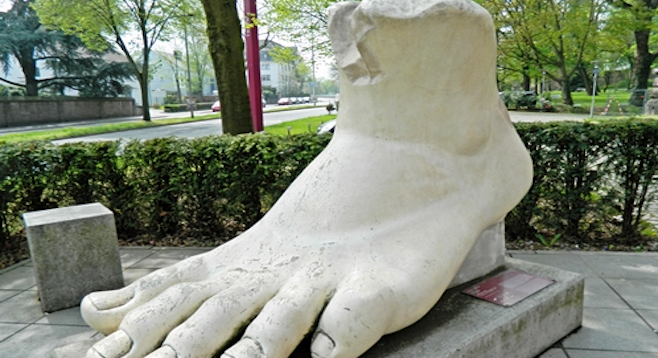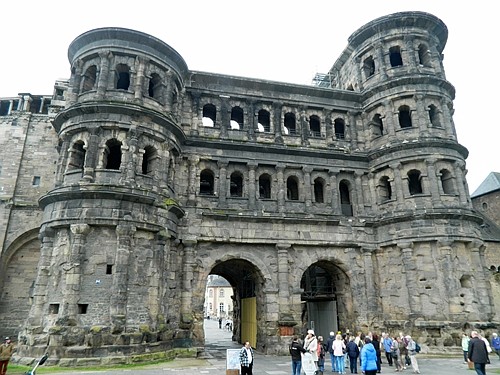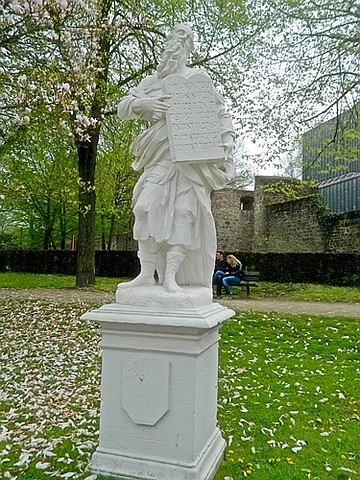 Facebook
Facebook
 X
X
 Instagram
Instagram
 TikTok
TikTok
 Youtube
Youtube

Germany’s most ancient city is Trier, its name derived from the Roman name Augusta Trevororum under Caesar Augustus. It was known as the “Second Rome” before Constantinople. While the Romans had been in neighboring Gaul – France – this was their first foray into the strategic area on the Mosel River, near the Rhine.

Being at the southwest corner of the country, its weather is the most mild. Pre-Roman Celts were the first to plant vineyards on the super-steep hills, but historians think that it was a different variety, Alpling, than the world’s finest Rieslings known to have been harvested there since the Middle Ages.
Whether because of the topography preventing McMalls, or UNESCO saving the day with its “World Heritage Site” designation, many of the Roman ruins around town are remarkably well preserved. Even modern businesses in town have felt the pressure to step it up with charming storefronts. Karl Marx was born in Trier. Oddly enough, “Karl Marx Strasse” is the town’s red light district.

What to do. Porta Nigra (“Black Gate”) is Trier’s iconic landmark and a UNESCO World Heritage Site. You can’t miss the massive black stone structure that opens into the historic center of the city (left). This is clearly the place to meet friends, have your picture taken, etc.
The amphitheater – complete with two vomitoria – is the only Roman ruin in the area that’s handicapped accessible. You can also see where lions and other beasts bided their time before fighting for their lives.
The Cathedral of Trier is Germany’s oldest cathedral, and it’s still in use. An interesting hodgepodge of architecture, its earliest elements date from the conversion of Emperor Constantine. Outside are two clocks: One says in Latin, “Wake and pray.” The other, “You do not know what time the Lord is coming." It, too, is a UNESCO World Heritage Site.

The Trier Landesmuseum has an amazing number of gigantic Roman structures – monuments, gates, etc. – as well as the largest Roman gold coin collection ever discovered. The museum starts at the beginning, James Michener style, with prehistoric artifacts, and goes through the Baroque era. Don’t miss the nearly 900-year-old Jewish tombstones. After you've prowled around the museum as you normally would, sign up for “In the Realm of Shadows,” a rather psychedelic light and sound show amidst the artifacts.
The museum is on one end of the free-to-walk-through Palace Gardens, with flowering trees and beautiful statuary.
Where to eat. Weinsinnig (“Wine intimately”) is a tiny little wine bar and shop on a medieval side street. You can learn about and drink wines from the family-run vineyards in the area, mostly Riesling. There are many different styles of Riesling!
Their insanely tasty snack, the tarte flambé, is like the best pizza you’ve ever had with a crispy, toasty wafer instead of boring chewy crust.
Get ready to scour cognates like a treasure map, because there’s no English menu at Zum Christophel in the Schroeder Hotel, and servers don’t speak it, either. However, there seemed to be a lot of American patrons, Lost in Translation–style. The restaurant is right next to Porta Nigra and serves traditional regional cuisine with modern twists. They incorporate seasonal local produce into their recipes, like the prized white asparagus.
G.F. von Nell is the 8th generation of a heroic noble family that’s had their vineyards since Napoleon’s time. Don’t worry about how to get there – he’ll come and pick you up in his bus in town! You can do wine tastings (left), hang out, see the vineyards, even camp onsite. In the restaurant, try an old family-favorite recipe: pork marinated in his wine and grilled on rootstock.
Where to stay. The Mercure has a fantastic location and great amenities – deep bathtubs, heated towel racks – that Americans are sure to appreciate.
However, breakfast is where the hotel really shines: huge picture windows look right onto the Porta Nigra. Artisan local honeys and jams are laid out before a grand variety of breads. Because Trier is on the Luxembourg border, there are French-style fancy cheeses and croissants. The German influence is there, too, of course: calves’ liver sausage, scalded ham and what epicure Brillat-Savarin pronounced the “most nutritious”: bloodwurst (black pudding sausage).


Germany’s most ancient city is Trier, its name derived from the Roman name Augusta Trevororum under Caesar Augustus. It was known as the “Second Rome” before Constantinople. While the Romans had been in neighboring Gaul – France – this was their first foray into the strategic area on the Mosel River, near the Rhine.

Being at the southwest corner of the country, its weather is the most mild. Pre-Roman Celts were the first to plant vineyards on the super-steep hills, but historians think that it was a different variety, Alpling, than the world’s finest Rieslings known to have been harvested there since the Middle Ages.
Whether because of the topography preventing McMalls, or UNESCO saving the day with its “World Heritage Site” designation, many of the Roman ruins around town are remarkably well preserved. Even modern businesses in town have felt the pressure to step it up with charming storefronts. Karl Marx was born in Trier. Oddly enough, “Karl Marx Strasse” is the town’s red light district.

What to do. Porta Nigra (“Black Gate”) is Trier’s iconic landmark and a UNESCO World Heritage Site. You can’t miss the massive black stone structure that opens into the historic center of the city (left). This is clearly the place to meet friends, have your picture taken, etc.
The amphitheater – complete with two vomitoria – is the only Roman ruin in the area that’s handicapped accessible. You can also see where lions and other beasts bided their time before fighting for their lives.
The Cathedral of Trier is Germany’s oldest cathedral, and it’s still in use. An interesting hodgepodge of architecture, its earliest elements date from the conversion of Emperor Constantine. Outside are two clocks: One says in Latin, “Wake and pray.” The other, “You do not know what time the Lord is coming." It, too, is a UNESCO World Heritage Site.

The Trier Landesmuseum has an amazing number of gigantic Roman structures – monuments, gates, etc. – as well as the largest Roman gold coin collection ever discovered. The museum starts at the beginning, James Michener style, with prehistoric artifacts, and goes through the Baroque era. Don’t miss the nearly 900-year-old Jewish tombstones. After you've prowled around the museum as you normally would, sign up for “In the Realm of Shadows,” a rather psychedelic light and sound show amidst the artifacts.
The museum is on one end of the free-to-walk-through Palace Gardens, with flowering trees and beautiful statuary.
Where to eat. Weinsinnig (“Wine intimately”) is a tiny little wine bar and shop on a medieval side street. You can learn about and drink wines from the family-run vineyards in the area, mostly Riesling. There are many different styles of Riesling!
Their insanely tasty snack, the tarte flambé, is like the best pizza you’ve ever had with a crispy, toasty wafer instead of boring chewy crust.
Get ready to scour cognates like a treasure map, because there’s no English menu at Zum Christophel in the Schroeder Hotel, and servers don’t speak it, either. However, there seemed to be a lot of American patrons, Lost in Translation–style. The restaurant is right next to Porta Nigra and serves traditional regional cuisine with modern twists. They incorporate seasonal local produce into their recipes, like the prized white asparagus.
G.F. von Nell is the 8th generation of a heroic noble family that’s had their vineyards since Napoleon’s time. Don’t worry about how to get there – he’ll come and pick you up in his bus in town! You can do wine tastings (left), hang out, see the vineyards, even camp onsite. In the restaurant, try an old family-favorite recipe: pork marinated in his wine and grilled on rootstock.
Where to stay. The Mercure has a fantastic location and great amenities – deep bathtubs, heated towel racks – that Americans are sure to appreciate.
However, breakfast is where the hotel really shines: huge picture windows look right onto the Porta Nigra. Artisan local honeys and jams are laid out before a grand variety of breads. Because Trier is on the Luxembourg border, there are French-style fancy cheeses and croissants. The German influence is there, too, of course: calves’ liver sausage, scalded ham and what epicure Brillat-Savarin pronounced the “most nutritious”: bloodwurst (black pudding sausage).
Comments